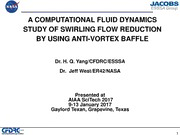
NASA Technical Reports Server (NTRS) 20170001497: A Computational Fluid Dynamics Study of Swirling Flow Reduction by Using Anti-Vortex Baffle A Computational Fluid Dynamics Study of Swirling Flow Reduction by Using Anti-Vortex Baffle PDF
Preview NASA Technical Reports Server (NTRS) 20170001497: A Computational Fluid Dynamics Study of Swirling Flow Reduction by Using Anti-Vortex Baffle A Computational Fluid Dynamics Study of Swirling Flow Reduction by Using Anti-Vortex Baffle
A COMPUTATIONAL FLUID DYNAMICS STUDY OF SWIRLING FLOW REDUCTION BY USING ANTI-VORTEX BAFFLE Dr. H. Q. Yang/CFDRC/ESSSA Dr. Jeff West/ER42/NASA Presented at AIAA SciTech 2017 9-13 January 2017 Gaylord Texan, Grapevine, Texas 1 Sloshing of Propellant Tanks Phenomena • Oscillations of the free surface of a liquid in a partially filled tank Significance • Potential source of disturbance that may affect the stability and structural integrity of space vehicles. • Can circulate sub-cooled propellant near the liquid vapor interface resulting in increased condensation and corresponding pressure collapse. Conversely: rapid vaporization and pressure rise near heated wall. • Concern for propellant surface orientation during Upper Stage burn (to ensure sufficient liquid propellant for engine firing). Driving Mechanisms • The driving slosh forces: lateral disturbance, oscillatory thrust force (TO), angular rotation during maneuverings. • It occurs during vehicle taxi, takeoff, engine shut off, and flight maneuvers. 2 OBJECTIVES AND APPROACH OBJETIVES ● To evaluate proposed anti-vortex design in suppressing swirling flow during US burn. APPROACH ● Include two major body forces in the analysis a) Vehicle acceleration (all three components); b) Vehicle maneuvers (roll, pitch, and yaw) ● Perform two drainage analyses of Ares I LOX tank using 6 LLHH22 TTaannkk DOF body forces predicted by GN&C analysis (Guidance Navigation and Control) during vehicle ascent: one with baffle, one without baffle. MODEL ● Use Ares I defined geometry. O-Grid for easy fitting of baffle. LOX Tank In this preliminary analysis the holes are sealed. ● Use whole 360 deg. model with no assumption of symmetry or cyclic boundary conditions. ● Read in 6DOF data vs time from a file. Simulation Model Computational Model ● CFD software: CFD-ACE+ with VOF module. ● Isothermal incompressible fluids for gaseous phase and liquid phases. Thermodynamic, non- isothermal flow condition is under validation. ● 223,000 total cells for LOX tank with baffle and 50,212 total cells for LOX tank without baffle. ● Constant gas and liquid physical properties: density, viscosity, surface tension. ● Laminar flow assumption. LOX drainage pipe ● Baffle is modeled as solid block with a thickness of m 2o in circumferential direction. ● When upper stage engine starts, the drainage pipe is prescribed as constant mass flow rate for LOX tank. Input Data Analysis Vehicle Linear Acceleration from Guidance Navigation and Control Analyses Booster Shutdown Causes a lower slosh frequency, and the amplified amplitude of residual slosh Upper Stage Engine Start Upper Stage Engine Shutdown Non-dimensional Time Vertical Acceleration at Center of Gravity (a ) cg x Input Data Analysis Vehicle Linear Acceleration from Guidance Navigation and Control Analyses Very small (about 1%) relative to vertical accelerations Y Direction Z direction Stage Separation Smooth ride during UP Non-dimensional Time Side Accelerations at Center of Gravity (a ) (a ) , cg y, cg z Maneuvering Data Analysis =roll; =pitch; and =yaw x y z Long moment arm 5 Angular Rotation (deg/s) 4 Roll 3 ) s Sources of swirling flow Pitch / g ed 2 Yaw ( d e e 1 p S r a 0 l u g n 0 100 200 300 400 500 600 A -1 -2 -3 Non-dimeTnismieo n(sa)l Time Side Loads due to Maneuvering: r Angular acceleration forces: (r) Centrifugal forces: Significant, and in high all, negligible !! frequency content Swirling Flows in Drainage Pipe without Baffle Three Major Contributing Factors to Swirling Flow in the Drainage Pipe: a) Rolling maneuvering: b) Sloshing due to pitch and yaw maneuverings and side loads c) Residual vortices transported from the tank during draining net side force Swirling flow due to side forces: Swirling flow due to rolling: two vortices side by side. symmetrical to the center of the tank axis. Transport Physics of A Vortex (from tank to pipe) By applying to N-S equations, and assuming incompressible flow, we have: D 2V D v consider x 2 x Dt x x x Dt x Stretching or titling Just as a scalar of vorticity transport with convection 0, for the current tank during draining, and diffusion →A positive source term for the convergent tank geometry x Vorticity strength increases as flow approaches the drainage pipe (conservation of angular momentum or stretching of vorticity) Earth-to-Orbit Smooth LOX Tank Simulation Non-dimensional Time Non-dimensional Time animation Cross-sectional velocity vector at drainage pipe Superposition of swirling flows due to roll and slosh
